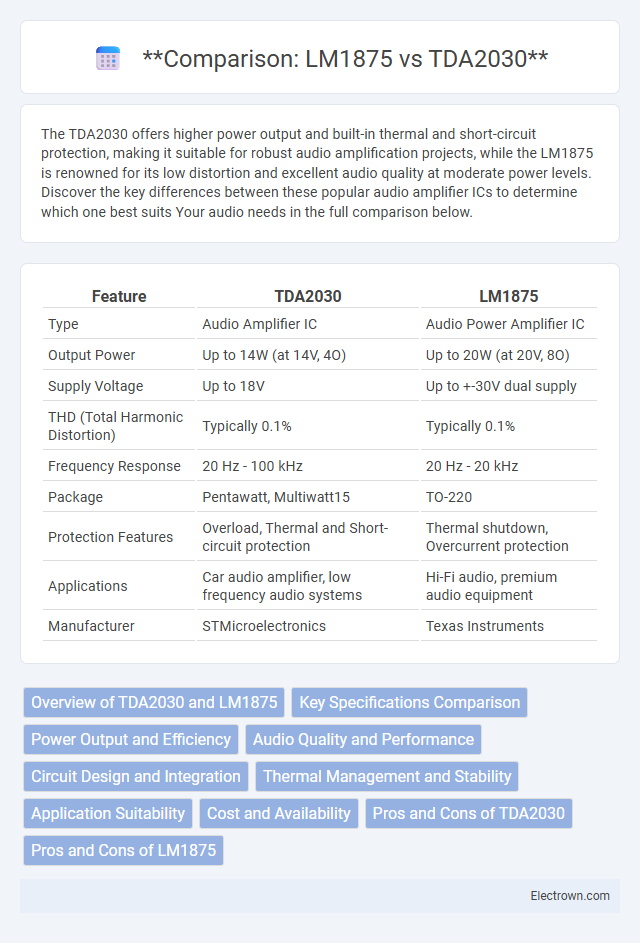The TDA2030 offers higher power output and built-in thermal and short-circuit protection, making it suitable for robust audio amplification projects, while the LM1875 is renowned for its low distortion and excellent audio quality at moderate power levels. Discover the key differences between these popular audio amplifier ICs to determine which one best suits Your audio needs in the full comparison below.
Table of Comparison
| Feature | TDA2030 | LM1875 |
|---|---|---|
| Type | Audio Amplifier IC | Audio Power Amplifier IC |
| Output Power | Up to 14W (at 14V, 4O) | Up to 20W (at 20V, 8O) |
| Supply Voltage | Up to 18V | Up to +-30V dual supply |
| THD (Total Harmonic Distortion) | Typically 0.1% | Typically 0.1% |
| Frequency Response | 20 Hz - 100 kHz | 20 Hz - 20 kHz |
| Package | Pentawatt, Multiwatt15 | TO-220 |
| Protection Features | Overload, Thermal and Short-circuit protection | Thermal shutdown, Overcurrent protection |
| Applications | Car audio amplifier, low frequency audio systems | Hi-Fi audio, premium audio equipment |
| Manufacturer | STMicroelectronics | Texas Instruments |
Overview of TDA2030 and LM1875
The TDA2030 is a 14-watt audio amplifier IC known for its low distortion and high output power in a compact 5-pin package, commonly used in car audio and low-frequency applications. The LM1875 is a higher-power audio amplifier IC offering up to 20 watts of output with low harmonic and crossover distortion, favored in hi-fi audio systems for its superior sound quality. Both amplifiers feature thermal overload protection and short-circuit protection, but the LM1875 generally excels in delivering cleaner audio with greater power headroom.
Key Specifications Comparison
The TDA2030 features a maximum output power of 14W into 4 ohms with a low distortion of 0.1% and operates at a supply voltage range of 7V to 18V, making it suitable for compact audio amplifier designs. In contrast, the LM1875 offers a higher output power up to 20W into 4 ohms, a very low harmonic distortion of 0.03%, and supports a wider supply voltage range of +-20V to +-30V, ideal for higher fidelity audio applications. Both ICs have built-in protection circuits, but the LM1875 is preferred for superior audio quality and higher power output.
Power Output and Efficiency
The TDA2030 delivers a power output of approximately 14W into 4 ohms with high efficiency suitable for compact audio applications, while the LM1875 offers a higher output power of up to 20W into 4 ohms with low distortion, favored in high-fidelity audio systems. The TDA2030 is a Class AB amplifier known for its thermal stability and efficiency around 50-60%, whereas the LM1875 achieves slightly better efficiency and superior audio quality due to its advanced internal circuitry. Both ICs balance power output and efficiency, but the LM1875 is preferred where audio clarity and higher wattage are prioritized.
Audio Quality and Performance
The TDA2030 delivers robust audio quality with low harmonic distortion and a smooth frequency response, making it ideal for mid-power audio amplifiers. The LM1875 offers cleaner sound reproduction and better signal-to-noise ratio, excelling in high-fidelity audio applications with minimal clipping at higher output levels. Both amplifiers perform well in stereo setups, but the LM1875 is preferred for audiophile-grade sound due to its superior linearity and lower total harmonic distortion (THD).
Circuit Design and Integration
The TDA2030 features a simpler circuit design with fewer external components, making it easier to integrate into compact audio amplifier projects. In contrast, the LM1875 offers a more robust circuit design optimized for low distortion and high signal-to-noise ratio, suitable for high-fidelity audio applications. Choosing between the two depends on your need for simplicity in integration or superior audio performance in your amplifier circuit.
Thermal Management and Stability
The TDA2030 features a robust thermal shutdown mechanism and an integrated heat spreader, enhancing heat dissipation and protecting against thermal overload, which ensures reliable operation under high power conditions. In contrast, the LM1875 relies heavily on external heat sinking and offers fewer internal protections, requiring careful thermal management to maintain stability and prevent thermal runaway. Effective heat management in the TDA2030 allows for higher efficiency and longer device lifespan compared to the LM1875 in audio amplifier applications.
Application Suitability
The TDA2030 is ideal for low to medium power audio amplification in car radios and home audio systems, offering efficient performance with minimal distortion. The LM1875 excels in high-fidelity audio applications and professional sound equipment, delivering higher output power and superior sound quality suitable for demanding audio environments. Choose your amplifier based on the specific power requirements and audio fidelity needed for your project.
Cost and Availability
The TDA2030 amplifier is generally more affordable and widely available, making it an attractive choice for budget-conscious DIY audio projects. The LM1875, while slightly higher in cost, offers superior audio performance and is moderately less common in the market. Your decision between the two should balance cost efficiency with the quality and availability of components for your specific application.
Pros and Cons of TDA2030
The TDA2030 offers high power output and low distortion, making it ideal for medium-power audio amplifier projects, with an efficiency of around 15-20% in typical Class AB operation. However, its thermal dissipation requires adequate heat sinking to prevent overheating, and it has a less robust short-circuit protection compared to the LM1875. Your choice depends on whether you prioritize the TDA2030's compact design and good sound quality or the LM1875's superior linearity and thermal stability.
Pros and Cons of LM1875
The LM1875 is renowned for its low distortion and high output power, making it ideal for hi-fi audio applications. However, it has limited thermal protection compared to the TDA2030 and requires a more complex external component setup. Despite its higher cost, the LM1875 delivers superior audio clarity and reliable performance in demanding amplifier designs.
tda2030 vs lm1875 Infographic

 electrown.com
electrown.com